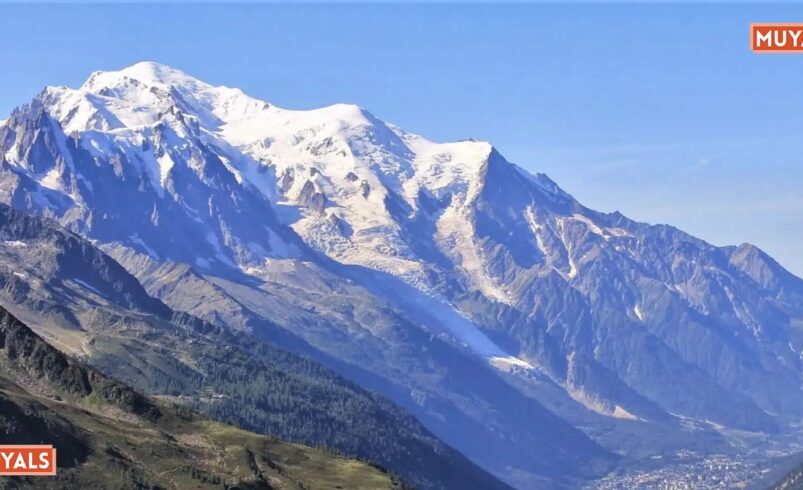Mount Blane: A Peak of Challenge and Beauty in the Opal Range
- September 23, 2025
- 0
Imagine standing atop a mountain, the Canadian Rockies sprawling out in front of you, with jagged peaks catching the first light of dawn. Below, valleys of dark pine

Imagine standing atop a mountain, the Canadian Rockies sprawling out in front of you, with jagged peaks catching the first light of dawn. Below, valleys of dark pine forests and rugged cliffs stretch to the horizon, offering a glimpse of the wildness that is still left in the world. This is the experience that awaits those who brave Mount Blane, one of Alberta’s lesser-known yet stunning peaks in the Opal Range. Whether you are a seasoned climber or an enthusiast of natural beauty, Mount Blane offers a challenge and reward that is hard to beat.
Mount Blane, located in the Opal Range of the Canadian Rockies, is a striking peak that rises to 2,993 meters (9,819 feet). This peak offers an intriguing combination of steep limestone cliffs, snow-capped ridges, and exposed alpine terrain, making it a prime destination for mountaineers seeking both a physical challenge and a chance to witness the untouched beauty of the Canadian wilderness.
While it may not be as well-known as some of its towering neighbors like Mount Assiniboine or Mount Jerram, Mount Blane’s distinctive features and its relatively untouched character make it a hidden gem for those willing to venture off the beaten path.
Mount Blane was named after Sir Charles Rodney Blane, a British naval officer who perished in the Battle of Jutland during World War I. His bravery and sacrifice were memorialized through this peak, which stands as both a tribute to him and a reminder of the sacrifices made during the war.
The first successful ascent of Mount Blane was achieved in 1955 by a group of mountaineers who, guided by their skill and determination, navigated the challenging ridgelines to reach the summit. Since then, the mountain has become a sought-after destination for experienced climbers looking for a more technical and rewarding climb.
Mount Blane, like much of the Opal Range, is composed of sedimentary limestone, laid down millions of years ago when this region was once under the sea. The geological history of this mountain is a fascinating story of ancient seas, shifting tectonic plates, and the eventual uplifting of these rock layers into the rugged peaks we see today.
The limestone found on Mount Blane is characteristic of the area, providing some of the most scenic and dramatic rock faces in the Canadian Rockies. The Opal Range is also known for its exposed ridges and alpine cliffs, creating a stunning contrast with the dense forests and valleys that surround the mountain.
For those who are up for the challenge, Mount Blane offers multiple climbing routes, each providing a different level of difficulty. The two primary routes are:
Mount Blane is not a peak for beginners. Its routes require solid climbing experience, including skills in rock climbing, ice climbing, and alpine navigation. The Northwest Ridge, while somewhat accessible for experienced mountaineers, still involves Class 5 climbing, which means climbers need to have knowledge of rope systems, belaying, and navigating rocky and icy terrain.
Mount Blane is located in a subarctic climate zone, meaning it experiences cold winters with heavy snowfall and mild summers. Temperatures can drop below freezing even in summer, particularly at higher altitudes, making preparation critical for safety.
The climbing season on Mount Blane is typically from June to September. During these months, snow melt reduces the risk of avalanches, and temperatures are more stable, making climbing more manageable. However, even in summer, climbers should be prepared for snow at the summit and the possibility of inclement weather.
Climbing Mount Blane is not just about reaching the summit—it’s about embracing the journey. The rugged terrain, technical routes, and breathtaking landscapes create an experience that challenges both body and mind. For mountaineers, summiting Mount Blane is an achievement that represents perseverance, skill. The reward of exploring one of the most beautiful and remote regions in Canada.
Mount Blane offers valuable insight into the geological history of the Canadian Rockies. Studying its limestone cliffs and rugged features allows geologists. Better understand the region’s past and the natural forces that shaped its current landscape. Additionally, the peak plays a role in local ecosystems, contributing to the water systems that feed into nearby valleys and forests.
To reach Mount Blane, climbers typically start from the King Creek Day Use Area, located off Highway 40 in Alberta. The King Creek Canyon is the primary access route, though it requires a significant hike to approach the base of the mountain.
Mount Blane, with its rugged beauty and technical climbing routes, stands as a hidden jewel in the Opal Range of the Canadian Rockies. Its challenging climbs, steep ascents, and breathtaking views make it a must‑visit for serious mountaineers and adventure seekers alike.
Beyond its physical challenges, Mount Blane represents the spirit of exploration. The desire to climb higher, to push boundaries, and to experience the wild, untamed beauty of the Canadian wilderness. Whether you’re climbing to conquer or simply seeking the beauty that awaits at its summit, Mount Blane offers an unforgettable journey for all who visit.
Mount Blane requires advanced climbing skills. The Northwest Ridge and Life Compass routes both involve technical climbing, rock scrambling, and exposure to steep, icy conditions.
The best time to climb Mount Blane is between June and September. During this period, snow melts, weather is more stable, and the longer daylight hours make it easier to complete the routes.
Climbers should ensure they have experience in alpine climbing, rock climbing, ice climbing, and route navigation. Proper equipment, acclimatization, and checking weather forecasts are essential for safety.
Visit More: Muyals